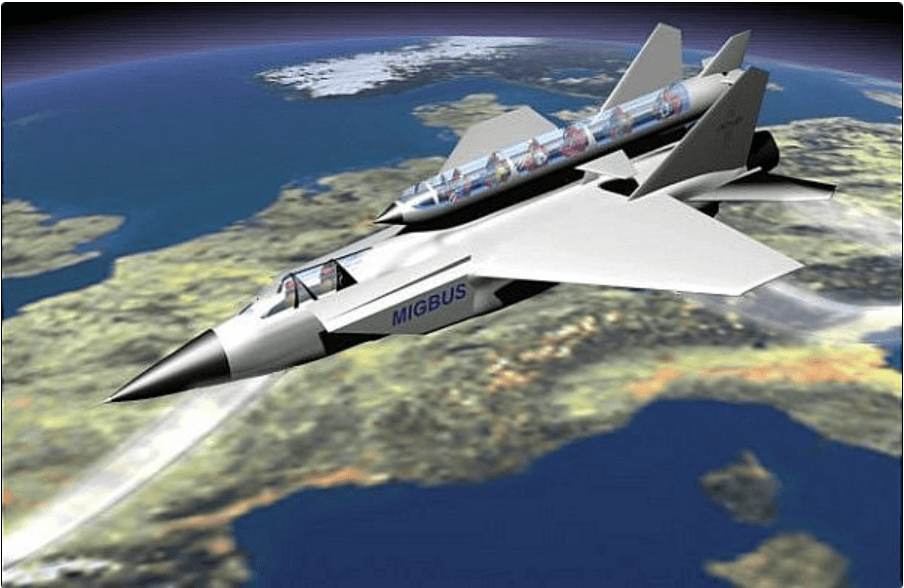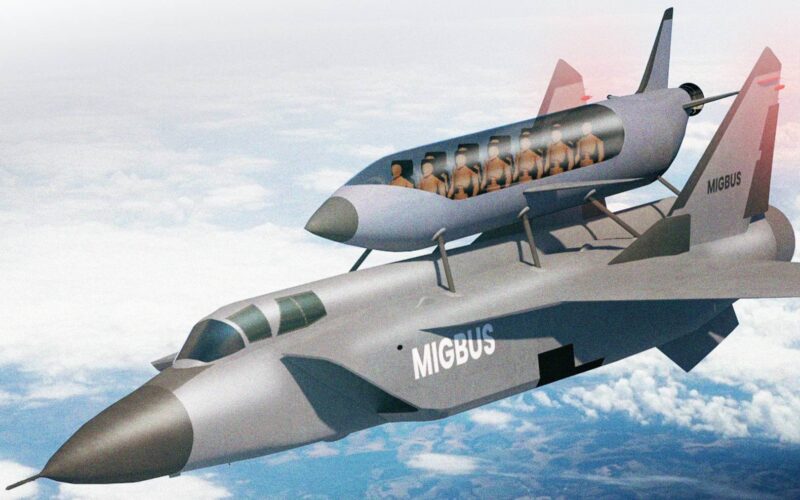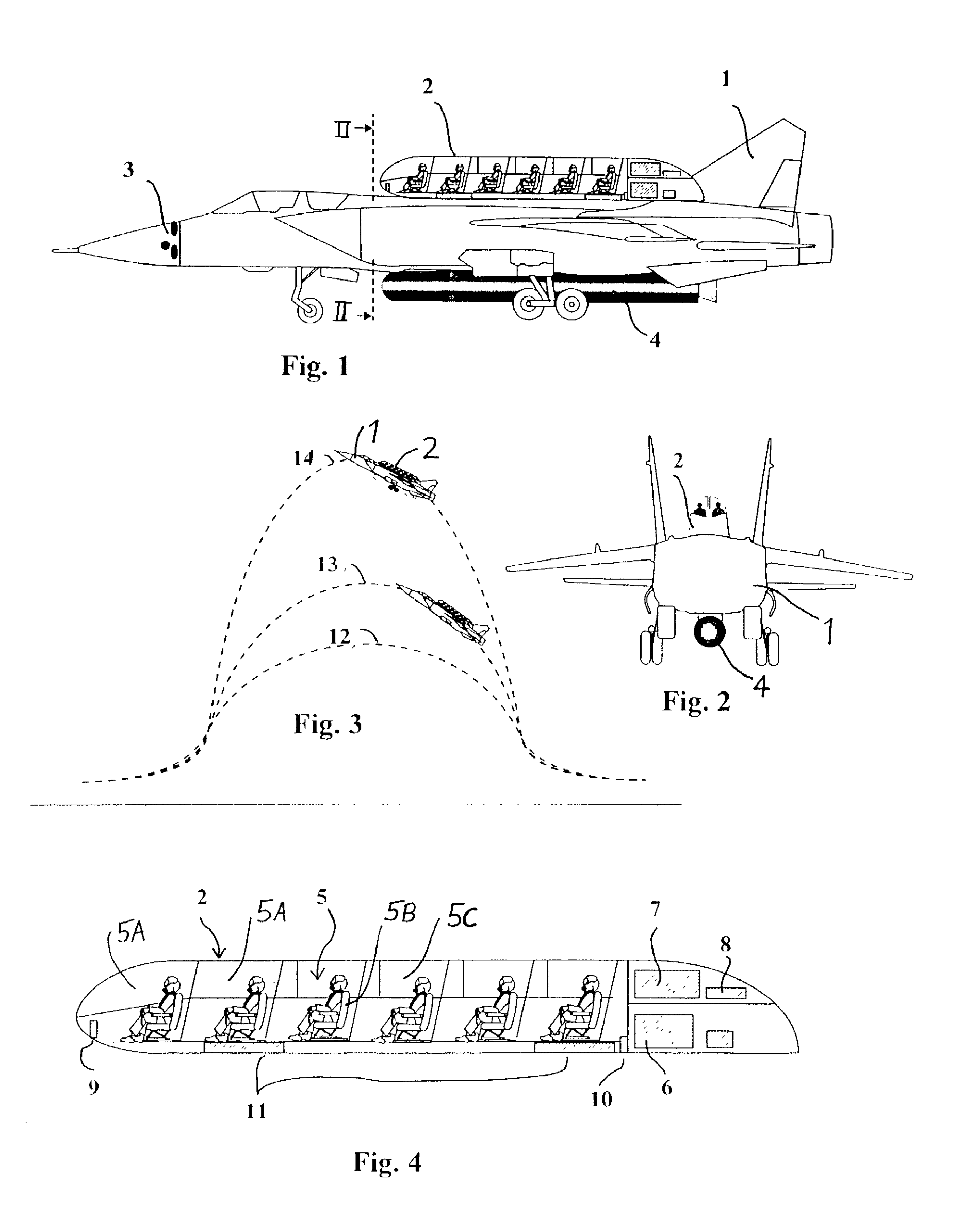Space tourism sounds exciting, but it is wildly expensive. In the early 2000s, Airbus had an idea to make it cheaper by creating Migbus: a transparent passenger capsule strapped to a MiG-31 fighter jet.
At present, private space exploration is one of the hot topics in the aerospace industry. It evolved from the huge interest in the sector back in the early 1990s through to the mid-2000s. As relatively cheap technology became available to westerners after the dissolution of the Soviet Union, and before the spaceflight was deregulated in the United States in 2004, a slew of private ventures popped up, promising an exciting adventure beyond the atmosphere, and a trip to the former Soviet Union to go with it.
EADS was the freshly formed European Aeronautic Defence and Space Company which manufactured Airbus aircraft. The company, which later changed its name to Airbus, tried to jump on the trend. Its space-oriented subsidiary Astrium SI (later renamed EADS Space Transportation) conducted a series of studies exploring the market, evaluating competitors and looking for proposals that could rival them.
WATCH NOW: our latest “AeroTime Explains” video tells the story of Migbus
The Foxbat adventure
Before SpaceX, Blue Origin and Virgin Galactic, one spaceflight option was offered by Space Adventures, the company which sent the first tourist to the International Space Station (ISS) in 2001. In addition to providing an opportunity to fly on board the Russian Soyuz for $20 million, the firm offered a cheaper option – a “flight to the edge of space” with the MiG-25 fighter jet for $10,000.
The Mikoyan MiG-25 Foxbat, a Cold War-era Soviet interceptor, was one of the fastest combat aircraft at the time with one of the highest operating altitudes. In 1977, it set the still unbroken flight altitude record for air-breathing vehicles by climbing to 37,650 meters – more than three times higher than the typical cruising altitude of an airliner. Beyond 30,000 meters, the sky turns black during the day and the curvature of the horizon becomes apparent, giving the illusion of being in space. Add to that several seconds of free fall during the dive back at a speed of Mach 2.5, and you could have an experience to match spaceflight at a fraction of the cost.
The problem is that the MiG-25 has just two seats and one of them must be occupied by an experienced pilot. In the 1960s, there were some serious proposals to turn the Foxbat into an airliner by adding a small passenger compartment in the nose, but they never materialized.
Also, the flight was considered to be dangerous and required serious training. The passenger had to learn all the emergency procedures and be prepared to eject if the ageing jet started misbehaving. Although there is no record of serious incidents, less serious ones did happen.
There had to be a better way to exploit the capabilities of high-flying Russian jets. It came at the turn of the 2000s.
Piggybacking on the MiG
In 2001, Alexander Van der Velden and Holger Stockfleth, the former of whom was a senior engineer at Astrium, filed a patent in Germany. A lengthy name of “Device for supersonic transport” does not really do it justice, but the gist of the idea was to attach a capsule to the back of a high-performance jet aircraft. Add large plexiglass windows, a parachute for safety, and you have a kind of rollercoaster cart which rides on a supersonic jet instead of tracks, and is capable of reaching the stratosphere.
Astrium proceeded to register it in the patent offices of the US, Russia, Australia, Japan, and the European Union the following year. It is unclear how many people worked on the idea and how seriously it was taken, but the patent was real.
It cited problems with the safety of the ex-Soviet aircraft, describing the need to mount the passenger compartment on latches or explosive bolts so it could be easily jettisoned in an emergency. The capsule would have a life support system, a canopy with 180° overhead view, and could sit between four and 12 people depending on the carrier – plus one flight attendant. Since such a contraption would result in immense drag, an additional rocket engine – either integrated into the capsule or a detachable one – would have to be fitted.
A scheme, detailing the attachment and layout of the capsule, as well as additional modification of the aircraft. From the patent issued by the United States Patent and Trademark Office in 2002. (Image: Astrium GmbH / Google Patents)
The patent used the MiG-31 Foxhound as an example of a possible carrier. It was more advanced, more powerful and a more robust successor to the Foxbat, but even its massive engines did not have enough power to carry the capsule at supersonic speeds, and it was just as difficult to control in the thin air of the stratosphere as any other aircraft. Therefore, the patent proposed attaching an underbelly booster rocket and adding multi-axis thrusters in the nose to improve controllability.
At some point, Astrium signed a memorandum of understanding with the MiG scientific-industrial complex, the former Mikoyan and Gurevich constructor bureau. An EADS report, released in 2004, said that the capsule concept itself was designed by MiG and that there is a lack of technical information about the project because the flight characteristics of the fighter jet are still classified. But it asserted that the project was moving forward, saying that an application letter had been filed to the German airworthiness authorities, a model had been tested in a wind tunnel by MiG, and a German professor, Peter Sacher, had completed his preliminary evaluation of the concept.
“No major showstopper was identified,” the report stated, but the “project is now in stand-by as for the moment it is lacking of financial support”.

Several years later, the German patent was withdrawn and the U.S. patent expired due to “fee-related” causes.
A number of 3D renders are floating round the Internet showing Migbus in varying levels of detail. The simplest one is from the EADS space tourism report and represents a rough idea without proper scale. A better one can be found in German newspapers of the period, depicting a bottle-shaped passenger capsule with a sharp nose, rocket boosters and a pair of additional stubby wings.
Meanwhile, no pictures of the wind testing model can be found, and the Russian side of the internet contains no information on the ‘Mig’ part of Migbus.
EADS completed its transformation into Airbus a decade later, with Astrium – now EADS Space Transportation – proposing and jettisoning several other space tourism ideas. Then the geopolitical situation changed again and Russia modernized its remaining MiG-31s, returning them to active duty and stopping any possibility of commercial use.
While the story behind the fast demise of Migbus is not entirely clear, seeing it in flight would no doubt have been impressive.
You can find AeroTime Explains Youtube channel HERE.


